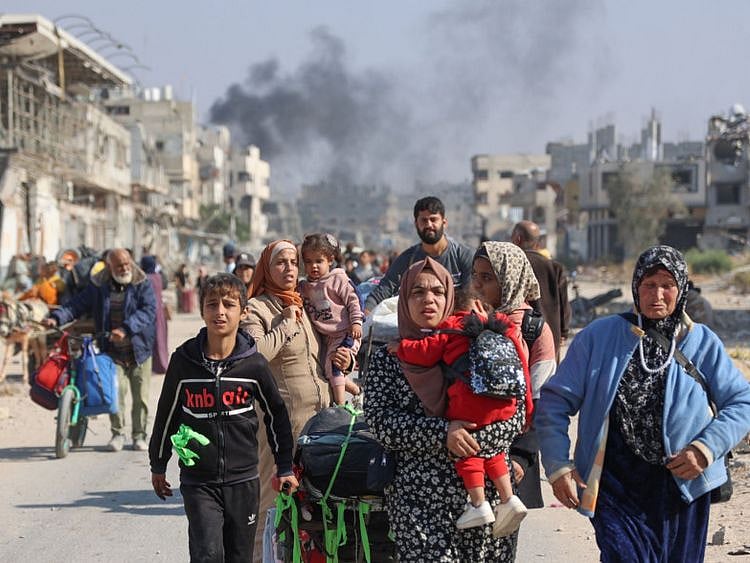Hamas responded on Friday to US President Donald Trump’s proposed plan for Gaza, which aims to end Israel’s conflict in the enclave.
Hamas expressed willingness to accept key elements of the plan, including a ceasefire, Israeli withdrawal, the release of Israeli hostages and Palestinian prisoners, humanitarian aid, and opposition to Palestinian displacement.
What Hamas is open to accepting
Hostage exchange: Hamas said it would release Israeli hostages, both living and deceased, “according to the exchange formula contained in President Trump’s proposal, with the necessary field conditions.” The group did not specify these conditions but expressed readiness for immediate mediated talks.
Ceasefire and Israeli withdrawal: Hamas accepted an end to hostilities and Israel’s “full withdrawal” from Gaza. While rejecting Israeli occupation, Hamas did not address the staged withdrawal outlined in Trump’s plan, which proposes frozen battle lines during the process.
Aid, recovery, and no Palestinian displacement: Hamas welcomed the surge of aid to Gaza and opposed Palestinian expulsion. The Trump plan specifies aid distribution through international bodies like the UN and Red Crescent, infrastructure rehabilitation, and freedom for residents to stay or leave as they choose.
Areas of divergence
Gaza governance: Trump’s plan proposes a temporary technocratic Palestinian committee, overseen by an international body led by Trump and including figures such as Tony Blair. Hamas prefers a Palestinian body of independents with Arab and Islamic support and did not comment on the proposed International Stabilization Force.
Hamas’ role: The Trump plan requires Hamas to have no governance role and to demilitarize Gaza. Hamas, however, insists on being part of a “comprehensive Palestinian national framework” and did not address demilitarization.
Amnesty and safe passage: Hamas’ statement did not respond to provisions granting safe passage to members who decommission weapons.
What does Trump’s Gaza peace plan promise?
Under pressure from Arab leaders and Washington, Hamas on October 3 accepted one part of President Trump’s proposed 20-point settlement: the release of remaining hostages. The group has not agreed to other terms, including disarmament and surrender of power in Gaza. Israeli Prime Minister Netanyahu has accepted the plan.
Implications for Hamas: The plan demands Hamas disarm and relinquish control of Gaza, which it has ruled since 2007. In exchange, Israel would end military operations, gradually withdraw, and allow international peacekeepers to take over. Hamas members would be granted amnesty if they give up arms, while those wishing to leave Gaza would receive safe passage.
Implications for Israelis: The plan promises the swift release of all hostages — 48 remain in Gaza, 20 believed alive — and a demilitarized enclave overseen by international monitors to prevent future threats.
Implications for Palestinians: Gazans would see an end to bombardment, immediate delivery of humanitarian aid, the release of around 1,700 Palestinian prisoners, and reconstruction of the territory. The plan also ensures that Israel will not annex Gaza or forcibly displace its population.
Who secures the peace: An International Stabilisation Force (ISF), led by the US, Arab states, and partners, would replace Israeli troops. The ISF would also train and build a new local police force to maintain security.
Trump’s 20-point Gaza peace plan
On Monday, Trump unveiled a 20-point plan at the White House, with Israeli Prime Minister Netanyahu expressing cautious support. Key elements include:
Gaza as a deradicalised, terror-free zone.
Redevelopment for the benefit of Gaza’s people.
Immediate cessation of war if both sides agree, with Israeli forces withdrawing to prepare for hostages’ release.
All hostages, alive or deceased, returned within 72 hours of Israel accepting the deal.
Israel releases Palestinian prisoners, including 250 life-sentence inmates and 1,700 detained since October 7, 2023.
Hamas members committing to peace may receive amnesty and safe passage.
Immediate humanitarian aid and infrastructure rehabilitation through international institutions.
Aid distribution supervised by UN, Red Crescent, and other impartial bodies.
Temporary technocratic governance of Gaza under international oversight.
Economic development plan to rebuild Gaza and attract investments.
Special economic zone with preferred tariffs.
Freedom of movement: no forced displacement.
Demilitarisation of Gaza, destruction of military infrastructure, and permanent weapons decommissioning.
Guarantees by regional partners for compliance and security.
Deployment of an International Stabilisation Force (ISF) for internal security.
Israel will withdraw gradually, retaining minimal security presence until Gaza is stable.
Aid operations proceed in terror-free areas even if Hamas delays the deal.
Interfaith dialogue to promote tolerance and peaceful coexistence.
Gradual path toward Palestinian self-determination and statehood.
US-facilitated dialogue between Israel and Palestinians for peaceful coexistence.
With inputs from AFP, AP and Bloomberg
Sign up for the Daily Briefing
Get the latest news and updates straight to your inbox
Network Links
GN StoreDownload our app
© Al Nisr Publishing LLC 2025. All rights reserved.
